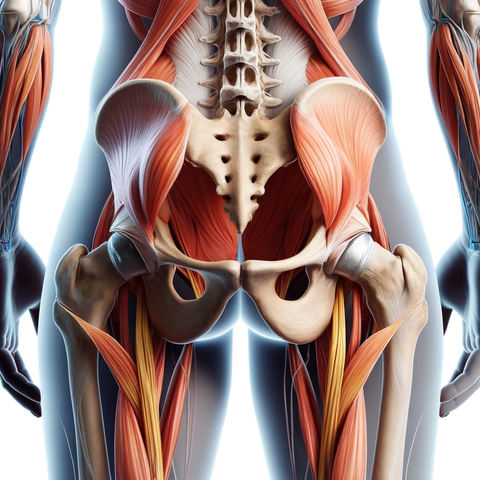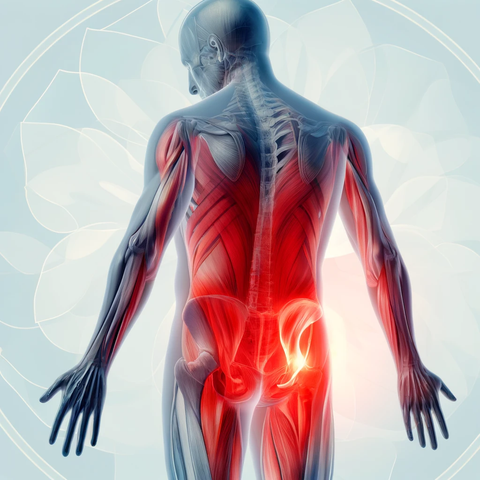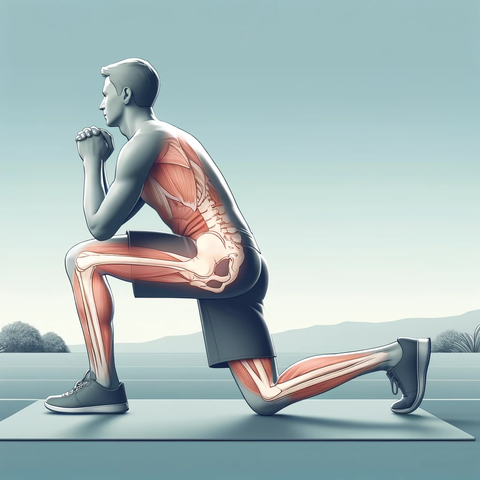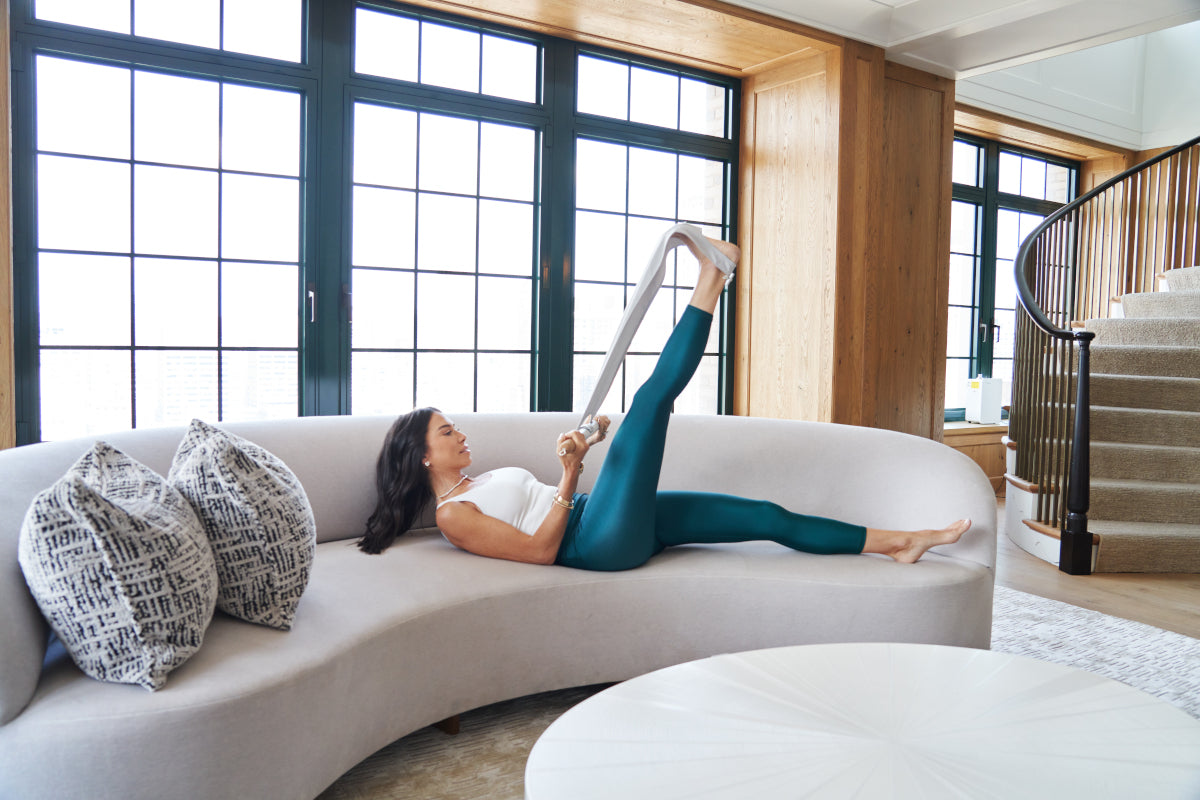Contents (Jump to a section)
What are the Causes of Hip Flexor Pain & How Can You Find Relief?

Cramping when you walk, difficulty getting out of a chair, struggling to walk up stairs, and an uncomfortable pulling feeling in your front hip are signs of a hip flexor issue, and they sure can make your life miserable!
Hip flexor pain is a common frustration, affecting people of all ages and lifestyles. Whether you're an athlete, an office worker, or simply someone who enjoys an active lifestyle, hip flexor pain can significantly impact your daily activities and overall quality of life. So, what causes hip flexor pain?
In this article, we’ll take a look at the common causes of hip flexor pain, and how you can avoid them. Plus, we’ll introduce you to some secrets to easing the pain and recovering as quickly as possible, including a game-changing device that will revolutionize the way you stretch!
An Introduction to the Anatomy of Your Hip Flexors

To understand the main hip flexor pain causes, it’s good to have a basic understanding of the anatomy of the hip flexor muscles. The hip flexors are a group of muscles located in the front of the hip joint, responsible for flexing the hip and bringing your thigh towards your torso. These muscles work together to support various movements such as walking, running, jumping, and even sitting.
The primary hip flexor muscles include the iliopsoas muscle, which consists of two parts: the psoas major and the iliacus, as well as the rectus femoris muscle. The psoas major originates from the lumbar spine and extends down to the front of the pelvis, while the iliacus muscle originates from the iliac crest of the pelvis. These muscles merge together to form the iliopsoas tendon, which attaches to the top of the femur (thigh bone).
The hip flexor muscles work in coordination with other muscles, including the glutes, hamstrings, and abdominal muscles, to facilitate smooth and efficient movement. When these muscles are balanced and functioning properly, they provide stability and allow for a full range of motion in the hip joint. Hip flexor pain occurs when they’re imbalanced, weakened, or strained.
Chronic Hip Flexor Pain Sympthoms

Hip flexor pain varies from person to person, mainly depending on the underlying cause. Many people experience sharp or stabbing pain in the front of the hip or groin region. The pain can be sudden and intense, making it difficult to move your leg or hip.
Hip flexor pain also often comes with tenderness, soreness, stiffness, and a reduced range of motion. It can be challenging and painful to walk, climb stairs, or bring your knee to your chest. Sitting for extended periods might also be uncomfortable.
For some, hip flexor pain may radiate to surrounding areas, such as the lower back, glutes, or down the front of the thigh. It can also lead to muscle weakness or a feeling of instability in the hip joint.
What Causes Hip Flexor Pain?
So, what causes hip flexor pain? Hip flexor pain can arise from acute injuries, chronic conditions, lifestyle-related issues, and everything in between. Understanding what’s behind your pain is essential for both preventing and treating hip flexor issues. Let’s take a look at some of the central hip flexor pain causes.
Strains and Tears
One of the most common hip flexor pain causes is muscle strains or tears. Overstretching or excessive force placed on the hip flexor muscles, often due to sudden movements or inadequate warm-ups, can lead to these injuries. Sprinting, kicking, or rapid changes in direction increase the risk of strains or tears in the hip flexors.
Direct Trauma
A direct blow or impact to the hip area, such as a fall or collision while playing sports, is another common hip flexor pain causes. The forceful impact can result in muscle contusions, bruising, or even fractures, leading to hip flexor pain and discomfort.
Arthritis
Hip flexor pain can also be associated with hip joint conditions, such as arthritis. Osteoarthritis, a degenerative joint disease, or inflammatory conditions like rheumatoid arthritis can cause joint inflammation, stiffness, and hip flexor pain.
Iliopsoas Bursitis
The iliopsoas bursa, a fluid-filled sac located near the hip joint, can become inflamed, leading to a condition known as iliopsoas bursitis. Overuse, repetitive movements, or direct trauma can irritate the bursa, resulting in hip flexor pain, tenderness, and swelling.
Impingement
Hip impingement, also known as femoroacetabular impingement (FAI), occurs when there is abnormal contact between the ball of the hip joint and the socket. This can lead to hip flexor pain, especially during activities that involve deep hip flexion or rotation.
Tendinopathy
Tendinopathy is another of the common causes of hip flexor pain. This painful condition refers to the degeneration or irritation of the tendons that connect the hip flexor muscles to the bone. Overuse, repetitive strain, or poor biomechanics can contribute to tendinopathy, causing hip flexor pain and localized tenderness.
Poor Posture and Sedentary Lifestyle
Good posture is so important, particularly for anyone working office jobs or spending long periods of time sitting at a desk. Poor posture can lead to a lot of joint and muscle issues and is one of the most common causes of hip flexor pain. When the hip flexor muscles are consistently in a shortened position, they can become tight and weakened over time, causing pain and discomfort.
Imbalance or Weakness in Other Muscle Groups
Muscle imbalances or weakness in the surrounding muscle groups, such as the glutes or core muscles, can also contribute to hip flexor pain. When these muscles are weak or fail to provide adequate support, the hip flexors may become overworked, leading to strain and discomfort.
Overuse Injuries
Repetitive movements or overtraining without proper rest can cause overuse injuries in the hip flexor muscles. Running, cycling, or dancing can place repetitive stress on the muscles, resulting in inflammation, micro-tears, and hip flexor pain.
Should You Get a Professional Diagnosis to Figure Out the Root Cause of Hip Flexor Pain?
If you try treating your hip flexor pain (more on how to do that soon!) and it persists for more than a few days, it might be time to see your doctor or a physical therapist to discuss the potential causes of hip flexor pain and how to find relief.
A healthcare professional can help you can differentiate hip flexor pain from other potential sources of discomfort, such as hernias, nerve impingements, or lower back problems. This is important when it comes to determining the most effective way to treat your hip flexor pain.
Best Tips on Hip Flexor Pain Relief

Now that we’ve discussed the main causes of hip flexor pain, what can you do to find relief? Here are some of the most effective techniques for beating hip flexor pain and getting back to your best as quickly as possible.
Give the Muscles Time to Heal Depending on the Hip Flexor Pain Cause
If your hip flexor pain is due to an acute strain or tear, it's essential to allow the muscles time to heal. Resting and avoiding activities that worsen your pain can help prevent further damage and speed up your recovery. Applying ice packs to your hip area for 15-20 minutes several times a day during the initial stages of healing can also help reduce inflammation and relieve your pain.
Strengthening and Mobilizing the Hip Flexors
Once the initial pain subsides, one of the best things you can do for your hip flexors is to incorporate strengthening and mobility exercises into your routine. Gentle stretching and flexibility activities like leg raises, lunges, and hip flexor stretches are very effective in not only healing your hip flexors, but also strengthening these muscles to prevent re-injury.
The easiest way to make sure you’re stretching safely and effectively is with specific stretching equipment like the CastleFlexx. The CastleFlexx brings you all the benefits of assisted stretching in your own home, without the need for expensive physical therapy visits or working with a trainer.
The CastleFlexx has a patented design that targets the entire posterior chain of your lower limb and relieves tension across your whole body. It’s not only one of the best devices for increasing hip mobility and stretching hip flexors, but it can also be used for ankle mobility exercises and plantar fasciitis pain relief. How long does it take to get flexible in your hips? Not long with the CastleFlexx on your side!
If you suffer from other painful conditions like shin splints, you can learn how to stretch shin splints using the CastleFlexx. It can significantly reduce your shin splint recovery time and have you back pounding the pavement before you know it!
Correcting Muscular Imbalances
Addressing muscular imbalances is crucial for long-term relief from hip flexor pain. Strengthening the surrounding muscle groups, such as your glutes, hamstrings, and core, helps provide better support to the hip flexors and reduce strain.
Engaging in targeted exercises like bridges, squats, and planks can help correct these imbalances and alleviate stress on the hip flexors. You can also use the CastleFlexx to correct imbalances by stretching tight or sore muscle groups. If you’re dealing with a tight calf and knee pain, tight glutes causing lower back pain, or wondering how to release tight calves, turn to your CastleFlexx!
Postural Adjustments
Improving your posture can significantly reduce hip flexor pain. Avoid sitting for too long altogether, but especially avoid it if you’re sitting with slouched or rounded shoulders, as this can lead to tightness and weakness in your hip flexors. Instead, sit upright with your shoulders back and your spine aligned, and consider using ergonomic supports, like a high-quality office chair or standing desk, to encourage better posture.
Other Lifestyle Changes
Certain lifestyle modifications can support your recovery and reduce hip flexor pain. Swimming, cycling, or water aerobics can provide low-impact cardiovascular exercise without too much strain on your hip flexors. At the same time, maintaining a healthy weight reduces the load on your hip joints, easing pressure on the hip flexor muscles.
Surgery as Treatment for Hip Flexor Injury
In most cases, hip flexor injuries can be effectively managed with non-surgical approaches such as rest, physical therapy, and lifestyle modifications. However, in rare and severe cases where conservative treatments do not provide relief or in instances of significant muscle tears, surgery may be considered as a treatment option for hip flexor injuries.
Tips for Preventing Hip Flexor Pain
By better understanding the causes of hip flexor pain, you can work to prevent it from occurring again in the future. One of the best ways to prevent hip flexor pain is to properly warm up before any kind of physical activity. Add some dynamic stretches that target the hip flexors to your routine, like glute bridges, planks, and even crunches.
Stretching daily with the CastleFlexx helps you build healthy, flexible, and strong hip flexors and surrounding muscles that are more resistant to tears or strains. It’s also a great way to start the day, as stretching improves your blood flow, promotes relaxation, and sets your entire day up for success.
When to Seek Professional Care for Hip Flexor Pain
While many cases of hip flexor pain can be managed effectively with self-care and lifestyle adjustments, there are times when seeking professional care is necessary. If your hip flexor pain is severe, recurring, or getting worse despite self-care measures, it’s time to call your doctor or physical therapist.
Severe pain may also indicate a more serious underlying condition that requires professional evaluation and treatment. If your hip flexor pain is accompanied by an inability to bear weight on the affected leg or difficulty walking, it may suggest a severe injury or structural problem.
Or, if you notice redness, warmth, swelling, or increased pain around the hip joint, you may have an infection. If you’re not sure, it’s always better to be more cautious and talk to your doctor about your hip flexor pain.
Final Thoughts on the Hip Flexor Pain Causes
Because hip flexor pain can have such a big impact on your daily life, it’s essential to understand the various hip flexor pain causes. Once you know what’s causing your hip flexor pain, you can develop the right treatment plan to relieve your symptoms and get back to feeling your best.
One of the best ways to find much-needed relief from painful hip flexors is with the CastleFlexx. Our patented stretching device, previously only available to professional athletes, helps you safely and effectively stretch your hip flexors and all the surrounding muscle groups, strengthening your core and lower posterior chain.
Say goodbye to hip flexor pain and welcome a healthier, happier, stronger, and more flexible you with the CastleFlexx!
